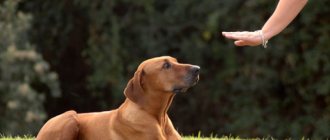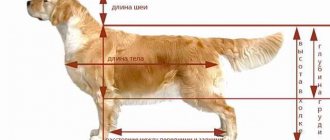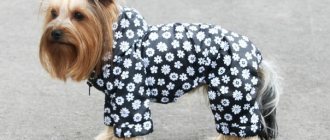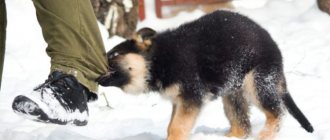The right relationship with the puppy must be established as quickly as possible. In this case, the reins of power should remain in your hands, but you should refrain from using force. Conduct yourself firmly and consistently, but with unfailing kindness. From the very beginning, the puppy must get it into his head that you are the leader. Believe me, this will make him much happier than possible doubts. Develop a code of rules, show the puppy where he sleeps. Establish a clear feeding schedule. Brush your puppy regularly - this is very important for establishing a trusting relationship. Only then will you understand how to become a leader for your dog
Annoying Behavior
Once you have gained authority, you must master the art of combating habits that, while just funny antics on the part of a puppy, turn into serious behavioral problems in an adult dog.
– Due to the owner’s incorrect behavior, this naughty puppy may imagine himself as a winner. Later it will be difficult for him to determine his place in the family hierarchy.
- Whenever I brush Brock, my 3-month-old springer spaniel, he growls menacingly and bites the brush. What should I do with it?
- Perhaps you're causing Brock pain - maybe the brush is too harsh or you're snagging hair? If not, then perhaps Brock is thereby making it clear that he does not intend to obey, or indeed observe discipline. Show him who's boss. Have someone hold Brock (with one hand behind his neck and the other under his belly) while you groom him. Continue the session for no more than 5 minutes, and reward the puppy with a treat when finished.
- Salsa, my 6 month old Chihuhua, keeps stealing our shoes and growls savagely if we try to take them away. What should we do?
- Try to play more games with Salsa like hide and seek. Don’t pamper her - don’t let her jump on the sofa and armchairs, don’t give her food at her slightest request. Hide your shoes and play fetch games outside. All this will require a lot of time and patience, but Salsa will learn to unquestioningly part with any of your things, including shoes.
Who's the boss of the house
Dogs are pack animals. Before getting to know an animal better, you need to know how dogs behave in a pack. Recent studies conducted in wolf packs indicate that wolves do not maintain their importance in the pack every day. Control of the flock occurs through sophisticated manipulations, body positions and postures, which are the main ones in establishing dominant positions.
It is extremely important for a dog in the house to become a kind of pack leader, and this happens through special obedience training. By becoming the main thing for the dog, you will be able to control the animal’s behavior, as well as create conditions that are comfortable for the owner and the dog. This will make it possible to significantly reduce the stress and possible anxiety experienced by the four-legged inhabitant of the house.
Note! If a dog begins to fear its owner, competing for the role of dominant in the pack. In this case, a person will need to change his attitude towards raising an animal, adding a positive approach to training.
There are some dogmas, adhering to which you can quickly determine the position of the dog in the house.
The main ones are:
- determination of dominant positions;
- understand what the dog wants;
- installation of unique psychological barriers;
- spending time together (games and entertainment);
- calmness of the owner in any situation.
First of all, you need to find out whether the animal exhibits behavioral problems - pulls on the leash when walking, behaves aggressively with other animals on the street, or barks at passers-by. It is important to prove yourself as a single leader, otherwise the dog will take on the functions of an alpha dominant. The owner of the animal will help eliminate increased anxiety and anxiety attacks in the dog by becoming the leader of the pack.
It is noteworthy that changes in a dog’s behavior can be made at any age.
Understanding the dog's condition is important. You need to understand that expressing your gratitude towards your pet only through touch or food is not correct. You can scold the dog for an offense, or praise it for a good deed with just one glance, conveying a range of informational messages.
An integral part of establishing a dominant position is strict control over the dog’s access to human resting places - beds, tables, sofas, armchairs. A dog that makes its own decisions will not consider its owner a leader. It is necessary to establish clear barriers to block the animal’s path to prohibited areas.
Note! The dog needs to be made to understand that it receives food only when it is calm - it does not jump and beg.
Showing firmness on the part of the owner in relation to the set situational barriers will allow the animal to understand where it can play and sleep, and in which rooms it is not recommended to be.
To balance the dog’s behavior and relationship with the owner, do not forget about playing together with your pet. The main task facing the leader of the pack is management and control over the actions of the animal. This can be demonstrated by your confidence, appropriate severity, love and fairness. It is the owner who must decide when games need to start and when they need to stop.
Showing calm is the basis for demonstrating dominance . True leaders in the wild rarely use threats and violence to enhance their status. The dog subtly senses changes in the emotional background of its owner, which is why it is important to control oneself when situations can drive a person crazy.
Case from practice
Tizzy, Dalmatian, 14 weeks
Circumstances: Lives in the family of Martin, who has three children aged 8 to 15 years.
The essence of the problem: Constantly gets underfoot, demands attention, chews children's toys and clothes.
Explanation: This behavior is completely normal for a Dalmatian puppy, but the family is asking for advice on what to do to prevent bad habits from getting worse in the future.
Recommendations:
- When Tizzy gets particularly fussy, take him out for a short walk (20 minutes is enough for his age), or start an active game outside.
- Create conditions for the puppy to rest so that he is not touched and he does not pester anyone. Leave him in a separate room or playpen for short periods of time. Put his bedding there too. After any solitary confinement, reward Tizzy with treats until he gets used to being alone sometimes.
- Tizzy should have his own toys. You should not scatter them around the house, but it is better to give them to the puppy at a certain time.
- Children should not throw clothes and toys around; they should be kept out of the puppy’s reach.
- A puppy crate in the corner of the living room allows your puppy some alone time. Place his bedding and toys inside.
Such problems include, for example, frantic greetings. Many puppies get so excited by the arrival of guests that they jump up on them to express their love. It's good when a dog is kind, but you shouldn't let it sit on your head. Make it so that the puppy has to greet guests more often, and then the thrill will disappear. And ask your guests to ignore the puppy until he calms down and stands on all four paws. And when you return home, do not express your intense joy at meeting the puppy, although this is not easy.
Another manifestation of unwanted behavior that needs to be eradicated initially is play biting. Puppies, growing up, often use their needle-sharp teeth during active games with their peers or their mother. If the bite is painful, the affected puppy will yelp or growl. An adult dog will growl more often and move away from overly naughty kids. And you can follow her example if the puppy bites your hand or trouser leg. Let out a loud scream, growl menacingly, and leave; There is no worse punishment for a puppy than being deprived of attention. Let it sit alone for 5-10 minutes and cool down. If after this the puppy continues to pester you, throw him some object that he can chew painlessly, for example, an edible bone.
Leader's Rules of Conduct
First of all, you need to strictly control the animal's access to food. At the same time, it is necessary to have access to fresh water on a constant basis. If an animal shows pronounced aggressive behavior and defends its bowl, this means that the dog does not see its owner as a leader.
To avoid the possible development of aggressiveness that occurs due to protecting one's bowl, it is necessary to take the bowl away from time to time when the animal is eating and then return it to its place. This will make it possible to demonstrate to your pet as clearly as possible who is in control of the situation. It is important to show that all items in the house belong to the owner.
Constant demonstration of leadership is an integral part of training and education. One of the easiest ways is to be the first to go through any doors, gates and gates, demonstrating your dominance. A trusting relationship between the dog and the owner will reduce the occurrence of increased anxiety in the animal when a person leaves the house.
You definitely need to visit places with your dog that are unfamiliar to it . The one who leads through unfamiliar territory is a leader. If unforeseen situations arise, you should never panic, scream and fuss. Animals feel that squealing is a sign of self-doubt, and a true leader cannot be afraid. It is important to teach a dog something new, since training automatically makes the owner a leader.
Rules for walks must be strictly regulated. It is not recommended to allow the dog to pull on the leash and get ahead of the owner. You can use a leash of standard sizes (up to 2 meters) so that the dog follows next to the owner or follows him.
Important! The boss should always go ahead on any walks, proving to the animal that it is the owner who is in control of the situation.
Teaching the correct commands to control your dog. The basic commands are:
- "To me";
- "Sit!";
- "Lie";
- "Place".
Having taught your pet commands correctly and in a timely manner, it will be easier for the animal to accept leadership from the owner. You can maintain interest in learning through the use of rewards and encouragement, affectionate words and strokes. You can start training small puppies as early as 2-3 months. But even adult dogs are able to remember and follow commands well.
An important point in establishing the owner as the leader of the pack is to properly ensure the dog is active. The owner must monitor the activity and health of the animal. Walks should be arranged several times a day, lasting up to half an hour. The appearance of inappropriate behavior (chewing furniture, shoes and objects) occurs due to the lack of activity of the animal.
Consistency implies adherence to clear rules regarding training. Violation or deviation from the established rules will confuse the four-legged friend, making him doubt that the owner is the leader of the pack. The response to bad behavior must be appropriate. It is necessary to act immediately, calmly giving an obedience command to the dog. The purpose of such a response is to demonstrate your dominance and stop the animal’s ugly behavior.
Time alone
You should train your puppy to be left alone for short periods of time every day. This will allow him to avoid being completely dependent on you, and will also prevent fear of loneliness and similar problems. Just take your time, even if at first the puppy has the opportunity to see you, but cannot get to you (a low partition in the doorway between rooms is ideal for this). Then close the door, leaving the puppy alone. Gradually increase your alone time sessions from 10 minutes to 1 hour. Leave as if nothing had happened, and under no circumstances return if the puppy starts whining. You can only approach him when he calms down. Praise him for his good behavior, but not too emotionally.
Source
Total Today: 1
How not to become a follower
Some owners jokingly say that they do not walk their pets, but their pets walk them. If it's just a joke, there's nothing wrong with it, but sometimes that's just how things are. Inexperienced owners should not have dogs whose breed implies a high level of independence. Most guard and service dogs know how and can make independent decisions in critical situations. This skill is very useful for four-legged dogs in work, but can lead to tragedy if the dog is raised by an inexperienced owner.
If you decide to get your first dog, it is better to start with a companion breed or a small mongrel. Companion breeds are a very large group of dogs, which over the centuries have acquired qualities that help serve humans. Service breeds are a completely different “caste” that has its own goals and follows them. For a service dog, guarding the territory or protecting the owner is a higher priority than his orders or desires.
A future owner who does not have experience in training and education should refrain from buying a puppy of hunting breeds. The big problem of these dogs is excitement, in the heat of which they do not hear commands and orders. Most hunting dogs are prone to running away and have difficulty learning to call. Oddly enough, a more reasonable alternative to the hunting breed are dogs of the so-called dangerous or fighting types. Yes, these dogs are specific and have an innate malice towards their relatives, but with proper upbringing, they grow into affectionate, “sofa” companion pets.
Different dogs, different people! Celebrity dogs. Interesting facts
Different dogs, different people! Celebrity dogs. Interesting facts.
If you need someone grateful, get a dog. (R. Harris)
In the modern world, the role of a dog as a companion has increased so much that you can see how people even climb mountains with their dog and parachute jump. And of course they take dogs on hikes, play with them at home. Dogs participate in police operations, special forces, the Ministry of Emergency Situations, help people with different problems.
Truly, whoever does not love dogs does not value loyalty!
Celebrity dogs
Paris Hilton, an extraordinary beauty, chose a Chihuahua dog as a companion; little beauty Tinkenbell will win the heart of anyone, just like her owner.
Russian TV and radio presenter, actress and dancer Lera Kudryavtseva chose a long-haired Chihuahua named Businka as her companion.
Philip Kirkorov made his favorite the white fluffy Spitz, which was presented to him by fans
But Alla Borisovna’s family chose a red spitz named Marusya, which their children love very much.
Russian singer and TV presenter, former lead singer of the group “Brilliant” Yulia Kovalchuk chose a Yorkshire terrier with an amazing name as a companion: Melody Blue Pearl!
The same breed was preferred by Victoria Daineko, she is accompanied by the Yorkshire terrier Tosik.
Ksenia Borodina, as well as Natasha Koroleva, made a similar choice. The names of their dogs are Strudya and Styopa.
Orlando Bloom was spotted cycling around town with his red poodle puppy!
The Lord of the Rings star is the owner of several dogs.
He has a Labrador, a Yorkshire terrier, and also a mongrel that he saved from apparent death on the street in Morocco where the movie “Kingdom of Heaven” was filmed. He just couldn’t get past this poor thing, whom he named Saidy.
By the way, many Hollywood stars commit noble deeds.
Selena Gomez picked up 6 dogs on the street!
Charlize Theron saved two dogs from straying - the Berkeley terrier and the pit bull Blue. The celebrity openly encourages everyone not to buy dogs, but to take them from shelters.
Brad Pitt and many other Hollywood stars share the same opinion.
Hollywood actress Jessica Chastain picked up her pet on the street
The dog turned out to be a purebred dog, but alas, without one paw. But this does not stop her from walking with her mistress and going with her almost everywhere. They can be seen together both at social events and on vacation.
Russian pop singer, film and voice actress, TV presenter Natalya Ionova, known to everyone as Glucose, preferred fluffy dog breeds - Akita - Inu and Cairn Terrier .50 kg - Akita - Inu named Muftik always accompanies his famous owner. The Cairn Terrier's nickname is Bublik.
As you noticed, there are both fluffy and smooth-haired dog breeds.
Dog fur is very healing, and high-quality dog clothes can protect not only from colds, but also from exacerbation of arthritis, radiculitis, and osteochondrosis.
Let's remember another disease that occurs from hypothermia. This is Raynaud's disease. During this disease, the blood supply to the hands is disrupted. This happens when a person's hands are cold
In order to prevent this, you need to wear warm mittens or gloves, preferably made from high-quality dog hair.
Take care of yourself dear readers!
Buy warm clothes in advance so that the cold doesn’t take you by surprise!
If not dominance, then what?
Fortunately, many trainers and trainers now base their work on more humane methods based on mutual understanding with the dog, without relying on military drill. Some trainers offer the concept of "leadership" or other similar terms, which are no longer as direct confrontation as in the schemes of "alpha male" and dominance. Such conflict-free and humane methods allow the pet not only to successfully get along with the human pack, but also help strengthen the owner-dog bond. For dogs with behavior problems, there are special training programs under the general name “NILIF” (“Nothing in Life is Free”) - “Nothing in this life is free.” This program requires the dog to do something specific to get the desired reward (for example, sitting down to get a treat, not pulling on the leash, etc.). These programs work successfully because the pet is given a clear set of rules that go from simple to complex. The dog consistently learns during the learning process what it needs to do to get food, affection, a toy, etc. But the dog does not know our language, therefore, living with us without our guidance, it may lose the meaning of life. Something similar happens to a person who is much better off living in a world governed by meaning and a clear structure. The tales of the dominance theory that a dog will stop obeying if it sleeps on the owner’s sofa, is the first to start food, or is the first to go through the door have no basis. True, this is true only for those dogs that already know how to obey and recognize the owner as an authoritative leader. Professional dog handlers must properly teach dog owners how to skillfully motivate their pets with gentle, positive actions so as not to violate the rules of their home. These rules do not imply that it is not at all necessary to necessarily defend your right to be the first to leave the house or sit on a chair. If you do not allow the small joys of life to your pet only because you fear that the dog will become the main one in the house, then this is not true. In fact, most dogs get along well with everyone in the family, despite the fact that they sleep on beds, beg at the table, and do many things that used to be considered dominant.
So, how can you describe working with a dog?
The first step is to establish a game plan or curriculum that is most likely to lead to the end goal. The best thing would be to get the whole family together and decide a number of questions about exactly how you want your puppy to behave and what rules will be accepted at home:
- Is it okay to let your puppy jump on beds and sofas?
- How would you like him to greet people?
- Where do you want him to be and what can he play?
- When is barking acceptable and when should it stop?
- How should a puppy react when people pay attention to him or offer him food?
- What signals or commands should he be taught and how to execute them well?
Next, you need to decide how everyone in the family will help the puppy learn that he behaves correctly in different situations.











